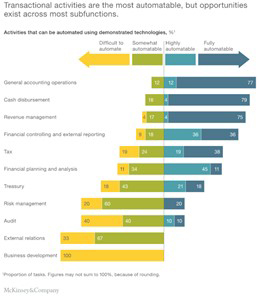
Louis Casari of HCL Technologies: Leveraging Hyperautomation Lending Solutions to Accelerate Business Growth
Louis Casari is Director of Digital Process Operations with HCL Technologies, Highlands Ranch, Colo.

The last two decades have witnessed some of the largest leaps in technological advancement, with terms such as artificial intelligence and robotics no longer confined to the realm of science fiction. In terms of technology adoption, financial services have always been on the cutting edge of this transformation. Whether it was the adoption of telegram-based wire transfers in the 1870s or high-frequency algorithmic trading in the 2000s – technology always drives innovation.
It is no surprise that today automation has become a common term for financial services. But, it’s only the beginning of the evolution. Today, we’re well on our way into hyperautomation as businesses’ across industries are realizing the multi-dimensional aspects of technology convergence. By combining multiple advanced technologies such as machine learning and RPA, businesses are innovating their workflows. Lending solutions is a prime area where hyperautomation can deliver significant benefits and accelerate the speed of growth.
Taking automation to the next level
For lending solutions, hyperautomation offers major transformative potential, with many of the top insurance and banking brands already making serious investments. At the outset, this digital trend has already drastically reduced manual, resource-intensive tasks while also opening up new opportunities for customer delight. If deployed strategically, hyperautomation can transform processes such as data re-keying or data entry in KYC, loan and credit application, while also servicing audit, compliance, and fraud detection.

(Application of hyperautomation across functions.)
Lending institutions are traditionally reliant on data processing tasks to achieve their broader business goals. Companies already leveraging automation-driven lending solutions have benefited by achieving higher cost savings, increased operational efficiency, and customer-centric services. Hyperautomation- driven lending solutions have the ability to take these improvements even further. It can integrate data from many sources and drive machine learning and RPA pipelines to drastically reduce labor-intensive processes such as error tracking, data extraction, and claim verification.
Most of the hyper-automation that is currently in place involves customer-facing processes. This is to address the self-service options that consumers want. A study found that 44% of banking customers prefer using their bank’s mobile app for acquiring services. But, there is a bigger purpose behind advancing toward data-intensive backend processes. With hyperautomation, lenders can leverage mobile platforms even more effectively to expedite processes and build a better customer experience. Customers can save time while filling in form registrations, finding the right services, or cancelling a policy at a much faster rate leading to greater customer experience, engagement and delight.
Turning technology advantage to customer-focus
It’s important to note that hyper automation is a people-centric business solution that doesn’t seek to replace humans. In fact, the use of machine learning, artificial intelligence, and robotic process automation serves to equally empower and augment people and processes to improve productivity. It is one step above automation and expands to encompass several other tools that can be further automated via multiple tools.
During the pandemic we’ve seen a remarkable strain on the human workforce. With distributed operations and a work-from-home model that has made many traditional processes difficult, if not impossible. As the effects of the pandemic continued to take hold, banks witnessed an increasing number of critical loan applications. However, the bandwidth and resources necessary to process them was in a crunch. By leveraging hyperautomation lending solutions, this bottleneck will no longer be a challenge as it would result in increased productivity and lower strain on the human workforce. It also offers reduced cost of ownership and processing costs to the business.
Along with an increasing number of loan applications, we also witnessed examples where hyper-automation technologies delivered real results. For instance, the CARES ACT or PPP was responsible for dispensing over $350 billion in fund across 800,000 SBA loan applications after the COVID-19 crisis. But to accomplish this, they only had 500 employees and the limited time of 3 months. Banks had to rely on RPA and other cognitive technologies as the parameters of the tasks weren’t feasible using their existing platforms.
The RPA/AIML services utilized bots to acquire 70% to 90% operational executions throughput that was accurate and scalable. These models aided in all steps of the loan processing cycle from discovery to analysis till the re-assessment phases. These RPA/AIML technologies lowered the entire SBA loan application to hours instead of weeks. Tools such as computer vision programs, document readers, OCRS engines, loan document reviews, risk or credit auto decision making converged under a hyperautomated lending solution deployment that resulted in higher accuracy and productivity gains.
Adopting a hyperautomation roadmap for the future
There is no doubt that hyperautomation technologies can catalyze business models to deliver higher trust, greater customer-centricity, and improved cost reduction. Big data algorithms have aided accurate research of the consumer to gauge their lifestyle and spending habits, thus helping them make prudent decisions when it comes to saving or spending.
A data-driven lending services business, based on a hyperautomated service platform, can transform lending service outcomes. However, many businesses find this kind of change intimidating or are entrenched in the usual ways of doing business. Unfortunately, the arc of technological innovation is currently at an inflection point where the choices are very clear – adapt and grow or risk obsolescence.
Such a choice requires courage, and leadership that can think beyond the uncertainty of the present to embrace the potential of the future. And, with hyperautomation, what better assurance can be offered than the ability to serve customers with a faster and painless process that is bound to win employee engagement and achieve higher productivity. The choice is yours.
(Views expressed in this article do not necessarily reflect policy of the Mortgage Bankers Association, nor do they connote an MBA endorsement of a specific company, product or service. MBA NewsLink welcomes your submissions. Inquiries can be sent to Mike Sorohan, editor, at msorohan@mba.org; or Michael Tucker, editorial manager, at mtucker@mba.org.)
